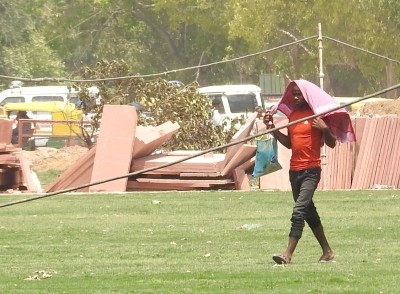
New Delhi, While extreme heat waves in the states of the northwest draw maximum public attention, the increase in overall anomalous temperature in other regions of the country have been largely neglected, indicated a new country-wide analysis by Centre for Science and Environment (CSE) on Thursday.
The seasonal average air temperature for 2022 summer was 1.24 degrees Celsius warmer than the baseline trends. Moreover, the heat waves lashing India this summer are symptomatic of the anomalous temperature trends that is expected to worsen with growing climate change impacts, it said.
Year 2022 summer was the second hottest after the summer of 2010. Mega cities, including Delhi, Mumbai, Kolkata and Hyderabad are much hotter than the larger region around them due to heat island effects caused by surface absorption of heat and local waste heat generated by traffic, industry and air conditioning (among other urban activities), the latest CSE analysis said.
Talking about the increase in overall anomalous temperature in other regions of the country that have been largely neglected, "This is a very disturbing trend as policy preparedness to mitigate rising heat due to climate change is nearly absent in India," said Anumita Roychowdhury, executive director, research and advocacy, CSE.
"Without heat action plans, rising air temperature, radiating heat from land surfaces, concretisation, heat-trapping built structures, waste heat from industrial processes and air conditioners, and erosion of heat dousing forests, urban greens and waterbodies will worsen public health risks. This requires urgent time-bound mitigation," she said.
Avikal Somvanshi, senior programme manager, Urban Lab, CSE, said: "Currently, the attention is largely on the maximum daily heat levels and extreme conditions of heat waves. But it is equally important to pay attention to the overall rising temperature and humidity trends in different regions to understand the gravity of the problem."
The Urban Lab of CSE has analysed the temperature trends in India from January 2015 till May 2022. The effort has been to understand the warming trends by covering all three dimensions of heat stress -- surface air temperature, land surface temperature, and relative humidity (heat index) -- at the national, regional and local levels.
The seasonal average air temperature for 2022 -- pre-monsoon or summer (March, April and May as per IMD classification) -- is 1.24 degrees Celsius warmer than the baseline trends that relate to 1971-2000 climatology.
Baselines are defined based on historical timelines and may vary for different metrics; the anomaly is generally computed from the 1951-80, 1971-2000, or 1981-2010 climatology baseline.
This is warmer than the 1.20 degrees Celsius anomaly noted in 2016 pre-monsoon, but lower than the 1.45 degrees Celsius anomaly recorded in the 2010 pre-monsoon season.
Similarly, land surface temperature anomaly has been extreme this pre-monsoon season, with a 1.46 degrees Celsius departure from the baseline (1971-2000). It must be noted that pre-monsoon seasonal trends in both land and air temperature are identical to the annual trends, but with more pronounced highs and lows.
Monsoon is hotter than the pre-monsoon period on an average, while winter and post-monsoon seasons are warming up faster.
High heat stress and heat waves in the northwestern states, but Other regions even hotter in absolute terms.


.jpeg)

